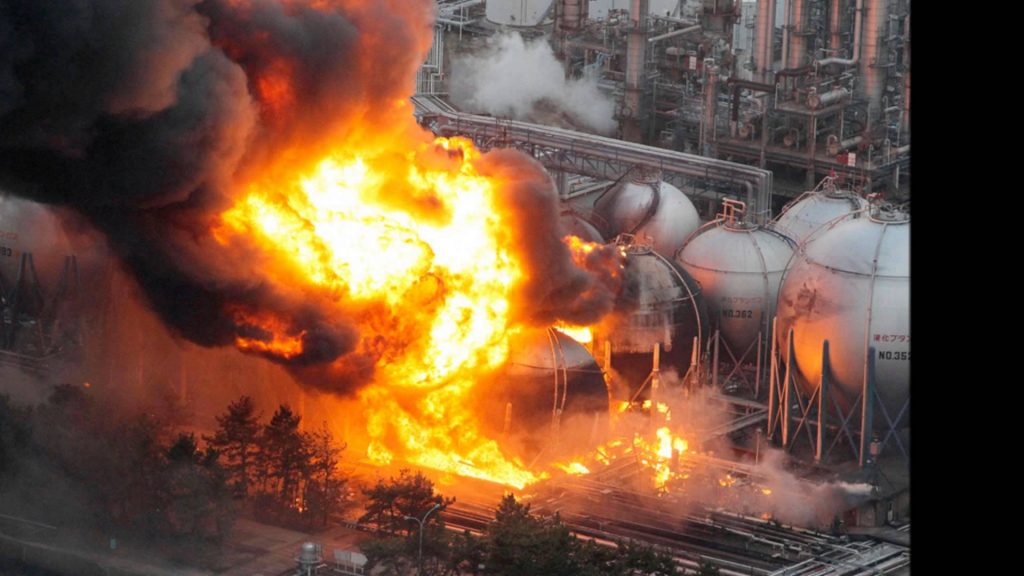Natural disasters are very common but tragic events around the world. From earthquakes to tornadoes, geological disasters can cause increasingly damaging effects, affecting the landscape and those who find themselves there. But when these events are combined with man-made artifacts, the effects might be even greater. An example of this is the Fukushima Disaster in Japan, the worst nuclear disaster since the 1986 Chernobyl incident.1 But the cause of this horrific disaster wasn’t particularly a man-made event. In fact, it all started with a wave.

On March 11, 2011, an earthquake with a magnitude 9.0—the worst to ever hit Japan—hit the country. It was such a powerful catastrophe, that Japan’s main island, Honshu, was permanently moved more than two meters to the east. As the earthquake gained momentum, waves up to 40 meters began crushing the country’s coast. The effects of the earthquake and the waves were too much for the Japanese. More than 20,000 people died or went missing and hundreds of thousands more lost their homes.2 But the worst was yet to come. Fifty minutes after the initial earthquake, a ten-meter high sea wall hit the Fukushima Daiichi (Number One) nuclear power plant. The water flooded the plant’s emergency power generators, knocking vital cooling systems offline, triggering a meltdown of reactor fuel rods. These then leaked deadly radiation into the coastal atmosphere of Japan. With the cooling systems not working, hydrogen gas built up in the reactor buildings, causing several hydrogen explosions in the following days of the earthquake.3

Because of the highly toxic radioactive material that leaked to the surrounding areas of the power plant, the government began to evacuate 80,000 people from a twelve-mile radius. Technicians turned to several things to try to cool the nuclear fuel, like using fresh water, seawater, and injecting nitrogen into the reactor containment buildings to prevent further explosions.4 But despite the efforts to try to help the people of Honshu, the government didn’t tell the people the truth. The official statistics of the event and even the admittance that the meltdown had taken place weren’t disclosed until eighty-eight days later.5
It was estimated that more than 800,000 tons of highly-radioactive material sat near the accident, which was slowly getting into the ground and moving towards the ocean. Although many people were evacuated, there were still many that couldn’t leave. The government installed temporary housing that was intended to house tens of thousands of people after the disaster for twenty-four months. But five years after the disaster, thousands of people were still living where they were surrounded by the radioactive material. Many of those who remained were the elderly and low-income families who had few options to move away.6

Several months after the disaster, people in other parts of Japan began rallying to help these people and bring an end to nuclear power plants in Japan. This pushed forward for the closure of all of the other nuclear plants in Japan for maintenance and inspection.7 These protests also pressured the government to issue a report on the disaster at Fukushima. This report criticized TEPCO (the Tokyo Electric and Power Company) for failing to address concerns about safeguards at the plant. This report also included information about how TEPCO officials had ignored engineers’ concerns that a seawall constructed to protect against major tsunamis as they had seen on March 11 was not sufficient. The report additionally criticized safety regulators for not implementing proper safety measures and for failing to adopt global nuclear safety standards.8 This was really important for the Japanese because TEPCO had always emphasized that the nuclear generators were “fail-safe,” that the facility was completely earthquake resistant and that the reactors would be able to withstand a major tremor.9
Five years after the disaster in Japan, several policies were changed to address the rising concerns of the Japanese population regarding nuclear power plants. The major decision of this kind was the decision to phase-out nuclear power plants during the 2030s as part of Innovative Strategy for Energy and the Environment adopted by the cabinet of the Democratic Party of Japan (DPJ).10 TEPCO is still facing criticism regarding the amount of nuclear material that was leaked into the environment and it is estimated that cleanup operations could take up to forty years.11
- Will Ripley, Junko Ogura, and James Griffiths, “Fukushima: Five Years after Japan’s Worst Nuclear Disaster,” CNN, March 11, 2016, sec. World. ↵
- Encyclopedia Britannica, 2018, s.v. “Fukushima Accident.” ↵
- New World Encyclopedia, 2017, s.v. “Fukushima nuclear disaster.” ↵
- New World Encyclopedia, 2017, s.v. “Fukushima nuclear disaster.” ↵
- Will Ripley, Junko Ogura, and James Griffiths, “Fukushima: Five Years after Japan’s Worst Nuclear Disaster,” CNN, March 11, 2016, sec. World. ↵
- Will Ripley, Junko Ogura, and James Griffiths, “Fukushima: Five Years after Japan’s Worst Nuclear Disaster,” CNN, March 11, 2016, sec. World. ↵
- New World Encyclopedia, 2017, s.v. “Fukushima nuclear disaster,” ↵
- Encyclopedia Britannica, 2018, s.v. “Fukushima Accident.” ↵
- Akira Nakamura and Masao Kikuchi. “What We Know, and What We Have Not Yet Learned: Triple Disasters and the Fukushima Nuclear Fiasco in Japan,” Public Administration Review 71, no. 6 (2011): 894. ↵
- Rie Watanabe, “After the Fukushima Disaster: Japan’s Nuclear Policy Change from 2011 to 2012,” Review Of Policy Research 33, no. 6 (2016): 623. ↵
- Alexis Dudden, “The Ongoing Disaster,” The Journal of Asian Studies 71, no. 2 (2012): 349. ↵


111 comments
Michael Lazcano
To think this happened only eight years ago is insane, I remember hearing it all over the news when it was happening. I even went to school with a friend who said he was living in Japan at the time when the disaster was taking place! I can’t imagine those people who were directly affected by such a disaster, and the road to recovery must’ve not been easy. It seems the placement of the plants and how the whole ordeal was handled was not the best they could’ve done. I have not followed the story of Japan since the event took place, but I hope that they are now taking the necessary precautions in order to prevent this from happening again.
Javier Camacho
As much as I praise the people who invest their time and energy in creating nuclear energy, I remember seeing this unfold on the news and being so confused as to how something like this could happen. I remember reading all about Chernobyl but this was in my lifetime and I remember being so heartbroken for the many people that were effected by this tragedy. That being said, I still think that we as a society have a lot to learn about nuclear energy and its side effects that are posed for our planet.
Michael Thompson
I remember this back in 2011, and how I thought it was interesting that this nuclear plant was getting as much coverage, if not more than the major tsunami that hit japan. Because at first it seemed the tsunami had a bigger impact. But looking back with all the people wearing face masks sick, this was a much bigger deal because this was affecting japans long term health, hurting them for decades.
Amanda Uribe
I remember hearing about how terrible these earthquakes were and how many people died from this hurricane. But I did not know that it made a nuclear power plant leak highly radioactive material. It is really sad that the government didn’t help all of the people affected by it. Just because you are elderly or poor does not mean you don’t deserve help. I really hope nothing like that ever happens again.
Kathryn Martinez
I’m reading this article as Japan was just hit by Typhoon Hagibis. It saddens me that Japan cannot get enough time in between events to recover. The death toll regarding natural events in Japan just continues to rise and it’s due to lack of allied support. I feel that if more countries were to reach out and help Japan with relief and preparation the country can begin to thrive again.
Roberto Rodriguez
I am all for nuclear energy, I think that it is the way of the future and it needs to continue to evolve and advance (especially in the safety category). That being said, I understand and I am concerned for the potential horrible disasters like Chernobyl or Fukushima. It is because of those disasters that I am always somewhat hesitant of the future, but nonetheless I have hope that in the future we will have clean nuclear energy. It is great to know how quickly the Innovative Strategy for Energy and the Environment was adopted and I hope that we continue to work for safety agreements in nuclear energy.
D'Hannah Duran
The effects of natural disasters are devastating especially when tied to something that was man made. There is nothing we can do to prevent what the Earth has in store for us but the effects of man made organizations can be assisted by the government. The image selection is great it gives a better depth to the article that cannot be show just through the way it is told.
Bianca Villarreal
It’s very upsetting to know that some people couldn’t evacuate because of low-income. I feel that knowing the possibilities of what can happen when natural disasters meet dangerous, man-made things, governments should always be prepared. Their citizens are a priority and no one should be left behind because of income. When you think about it from this perspective, it all comes down to how wealthy you are; the wealthy always have multiple options, but if you don’t have money, you’re out of luck. That shouldn’t be a country’s standard. Especially when a problem was made worse because of government regulated and man-made facilities.
Kelsey Sanchez
The earthquake causing a tremendous disaster later became a harsh one when the high sea that was a ten-meter high hit the Fukushima Daiichi nuclear power plant. It must have been hard for all the people who were affected. It was a big population to see that many died and were lost within this disaster occurring. It was surprising to see that people in other parts in Japan began a rally and protest to help these people out. They contribute to forming a rally in order to end these nuclear power plants. Luckily, policies were changed addressing the concerns of the Japenese population regarding nuclear power plants.
Jake Mares
The effects of nuclear fallout can devastate a country. The title picture really enhances the resulting effect that this spill had on the Fukushima people as the explosion sends out fallout everywhere. Also, the amount of particles released into the atmosphere (the 800,000 tons) is so extreme that it sounds irrational. This level of catastrophe trying to be covered up by the government seems impossible.